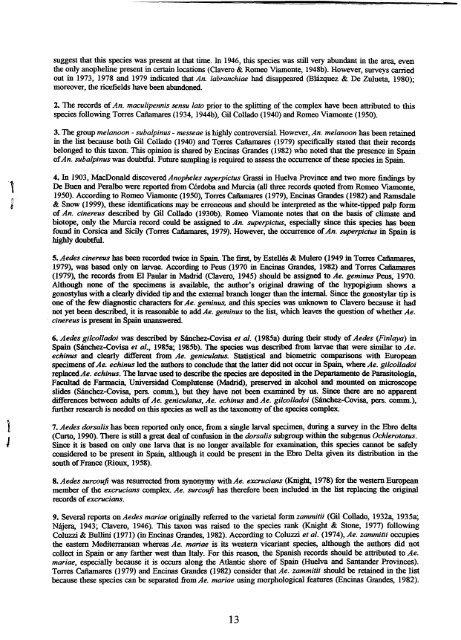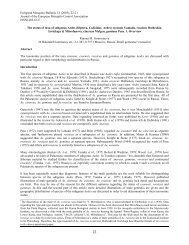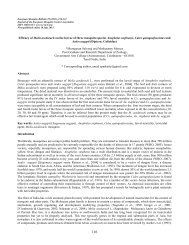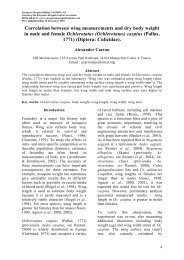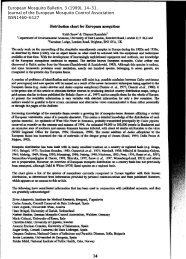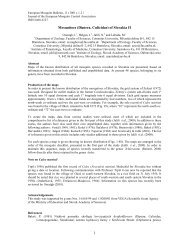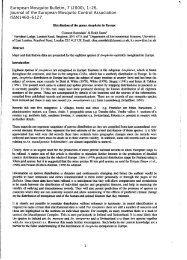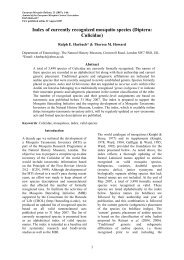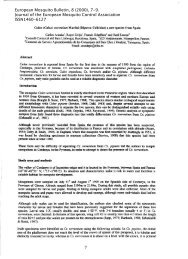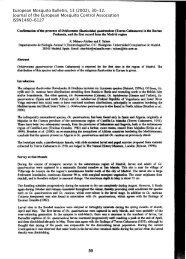European Mosquito Bulletin, 8 (2000), 10-18. Journal of the ...
European Mosquito Bulletin, 8 (2000), 10-18. Journal of the ...
European Mosquito Bulletin, 8 (2000), 10-18. Journal of the ...
Create successful ePaper yourself
Turn your PDF publications into a flip-book with our unique Google optimized e-Paper software.
suggest that this species was present at that time. In 1946, this species was still very abundant in <strong>the</strong> area, even<br />
<strong>the</strong> only anopheline present in certain locations (Clavero & Romeo Viamonte, 1948b). However, surveys carried<br />
out in 1973, 1978 and 1979 indicated that An. labranchiae had disappeared (Blazquez & De Zulueta, 1980);<br />
moreover, <strong>the</strong> ricefields have been abandoned.<br />
2. The records <strong>of</strong> An. macu/ipennis sensu lato prior to <strong>the</strong> splitting <strong>of</strong> <strong>the</strong> complex have been attributed to this<br />
species following Torres Caiiamares (1934, 1944b), Gil Collado (1940) and Romeo Viamonte (1950).<br />
3. The group melanoon - subalpinus - messeae is highly controversial. However, An. melanoon has been retained<br />
in <strong>the</strong> list because both Gil Collado (1940) and Torres Caiiamares (1979) specifically stated that <strong>the</strong>ir records<br />
belonged to this taxon. This opinion is shared by Encinas Grandes (1982) who noted that <strong>the</strong> presence in Spain .<br />
<strong>of</strong> An. subalpinus was doubtful. Future sampling is required to assess <strong>the</strong> occurrence <strong>of</strong> <strong>the</strong>se species in Spain.<br />
4. In 1903, MacDonald discovered Anopheles superpictus Grassi in Huelva Province and two more findings by<br />
De Buen and Peralbo were reported from COrdoba and Murcia (all three records quoted from Romeo Viamonte,<br />
1950). According to Romeo Viamonte (1950), Torres Caiiamares (1979), Encinas Grandes (1982) and Ramsdale<br />
& Snow (1999), <strong>the</strong>se identifications may be erroneous and should be intetpreted as <strong>the</strong> white-tipped palp form<br />
<strong>of</strong> An. cinereus described by Gil Collado (1930b). Romeo Viamonte notes that on <strong>the</strong> basis <strong>of</strong> climate and<br />
biotope, only <strong>the</strong> Murcia record could be assigned to An. superpictus, especially since this species has been<br />
found in Corsica and Sicily (Torres Caiiamares, 1979). However, <strong>the</strong> occurrence <strong>of</strong> An. superpictus in Spain is<br />
highly doubtful.<br />
5. Aedes cinereus has been recorded twice in Spain. The first. by Estelles & Mulero (1949 in Torres Cafiamares,<br />
1979), was based only on larva~. According to Peus (1970 in Encinas Glandes, 1982) and Torres Caiiamares<br />
(1979), <strong>the</strong> records from El Paular in Madrid (Clavero, 1945) should be assigned to Ae. geminus Pens, 1970.<br />
Although none <strong>of</strong> <strong>the</strong> specimens is available, <strong>the</strong> author's original drawing <strong>of</strong> <strong>the</strong> hypopigium shows a<br />
gonostylus with a clearly divided tip and <strong>the</strong> external branch longer than <strong>the</strong> internal. Since <strong>the</strong> gonostylar tip is<br />
one <strong>of</strong> <strong>the</strong> few diagnostic characters for Ae. geminus, and this species was unknown to Clavero because it had<br />
not yet been descnDed, it is reasonable to add Ae. geminus to <strong>the</strong> list, which leaves <strong>the</strong> question <strong>of</strong> whe<strong>the</strong>r Ae.<br />
cinereus is present in Spain unanswered.<br />
6. Aedes gi/co//adoi wasudescribed by Banchez-Covisa et al. (1985a) during <strong>the</strong>ir study <strong>of</strong> Aedes (Finlaya) in<br />
Spain (S8nchez-Covisa et al., 1985a; 1985b). The species was described from larvae that were similar to Ae.<br />
echinus and clearly different from Ae. geniculatus. Statistical and~iometric comparisons with <strong>European</strong><br />
specimens <strong>of</strong> Ae. echinus led <strong>the</strong> authors to conclude that <strong>the</strong> latter did not occur in Spain, where Ae. gilcolladoi<br />
replacedAe. echinus. The larvae used to descn'be <strong>the</strong> species are deposited in <strong>the</strong> Departamento de Parasitologia.<br />
Facultad de Farmacia, Universidad Complutense (Madrid), preserved in alcohol and mounted on microscope<br />
slides (Sanchez-COvisa, pers. comm), but <strong>the</strong>y have not been examined by us. Since <strong>the</strong>re are no apparent<br />
differences between adults <strong>of</strong> Ae. geniculatus, Ae. echinus and Ae. gilcolladoi (Sanchez-covisa, pers. comm.),<br />
fur<strong>the</strong>r research is needed on this species as well as <strong>the</strong> taxonomy <strong>of</strong> <strong>the</strong> species complex.<br />
1<br />
J<br />
7. Aedes dorsalis has been reported only once, from a single larval specimen, during a survey in <strong>the</strong> Ebro delta<br />
(Curto, 1990). There is still a great deal <strong>of</strong> confusion in <strong>the</strong> dorsalis subgroup within <strong>the</strong> subgenus Ochlerotatus.<br />
Since it is based on only one larva that is no longer available for examination, this species cannot be safely<br />
considered to be present in Spain, although it could be present in <strong>the</strong> Ebro Delta given its distribution in <strong>the</strong><br />
south <strong>of</strong> France (Rioux, 1958).<br />
8. Aedes surcoufi was resurrected from synonymy with Ae. excrucians (Knight, 1978) for <strong>the</strong> western <strong>European</strong><br />
member <strong>of</strong> <strong>the</strong> excrucians complex. Ae. surcoufi has <strong>the</strong>refore been included in <strong>the</strong> list replacing <strong>the</strong> original<br />
records <strong>of</strong> excrucians.<br />
9. Several reports on Aedes mariae originally referred to <strong>the</strong> varietal form zammitii (Gil Collado, 19328, 1935a;<br />
Najera, 1943; Clavero, 1946). This taxon was raised to <strong>the</strong> species rank (Knight & Stone, 1977) following<br />
Coluzzi & Bullini (1971) (in Encinas Glandes, 1982). According to Coluzzi et al. (1974), Ae. zammitii occupies<br />
<strong>the</strong> eastern Mediterranean whereas Ae. mariae is its western vicariant species, although <strong>the</strong> authors did not<br />
collect in Spain or any far<strong>the</strong>r west than Italy. For this reason, <strong>the</strong> Spanish records should be attributed to Ae.<br />
mariae, especially because it is occurs along <strong>the</strong> Atlantic shore <strong>of</strong> Spain (Huelva and Santander Provinces).<br />
Torres Cafiamares (1979) and Encinas Grandes (1982) consider thatAe. zammitii should be retained in <strong>the</strong> list<br />
because <strong>the</strong>se species can be separated fromAe. mariae using morphological features (Encinas Grandes, 1982).<br />
13


